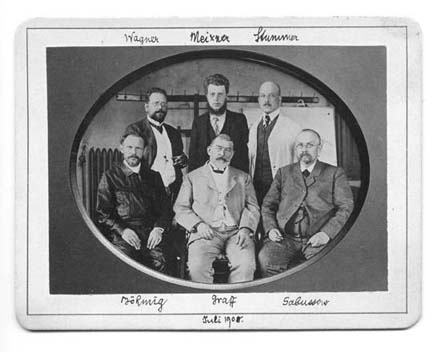History of Turbellarian Research

Graz, Austria, 1908
back row: Franz von Wagner, Josef Meixner, Rudolf Stummer Ritter von Traunfels
front row: Ludwig Böhmig, Ludwig von Graff, H. Sabussow
From Anno Faubel
Introduction
The history of research on the Turbellaria is about the men and women who labored to search out these soft-bodied worms, from the tiny ones living between sand grains to the readily visible and colorful flatworms of tropical reefs and humid forest lands.  Their work is both science and art. One cannot look at the reprints of their studies in this field without being struck by the shear beauty of the drawings, photomicrographs, and, more recently, the movies of these fascinating creatures. A handful of scientists and naturalists from Steinböck to Steinbeck have illuminated a fascinating and beautiful world foreign to most of us.
Their work is both science and art. One cannot look at the reprints of their studies in this field without being struck by the shear beauty of the drawings, photomicrographs, and, more recently, the movies of these fascinating creatures. A handful of scientists and naturalists from Steinböck to Steinbeck have illuminated a fascinating and beautiful world foreign to most of us.
The tiny turbellarians living in sediments are hidden from us in an environment so different from our terrestrial surroundings. Imagine that for such a turbellarian, a grain of sand represents a rock larger and heavier than itself.  Their lives involve navigating, feeding, and reproducing in the spaces between the sand grains or among the flocculent surface layers of muddy sediments. They are found everywhere throughout the oceans and freshwater habitats, and yet we have only begun to inventory the species. We can only guess at the number of individuals and species. Their natural history is fascinating. Most turbellarians are aquatic in marine sediments; some are pelagic or creep about on corals and other sedentary organisms, while others live in fresh water or in humid terrestrial environments.
Their lives involve navigating, feeding, and reproducing in the spaces between the sand grains or among the flocculent surface layers of muddy sediments. They are found everywhere throughout the oceans and freshwater habitats, and yet we have only begun to inventory the species. We can only guess at the number of individuals and species. Their natural history is fascinating. Most turbellarians are aquatic in marine sediments; some are pelagic or creep about on corals and other sedentary organisms, while others live in fresh water or in humid terrestrial environments.
When we look at the scientists who have studied turbellarians, we don't do them justice by simply counting the number of species they named or the number of scientific papers authored, but these statistics are a starting point.  Biographies of these people are hard to find, but do exist. We will attempt to locate and add to the biographical information and would encourage you to send such information to us to include in the Web site for all to read.
Biographies of these people are hard to find, but do exist. We will attempt to locate and add to the biographical information and would encourage you to send such information to us to include in the Web site for all to read.
comp. --- Steve Schilling